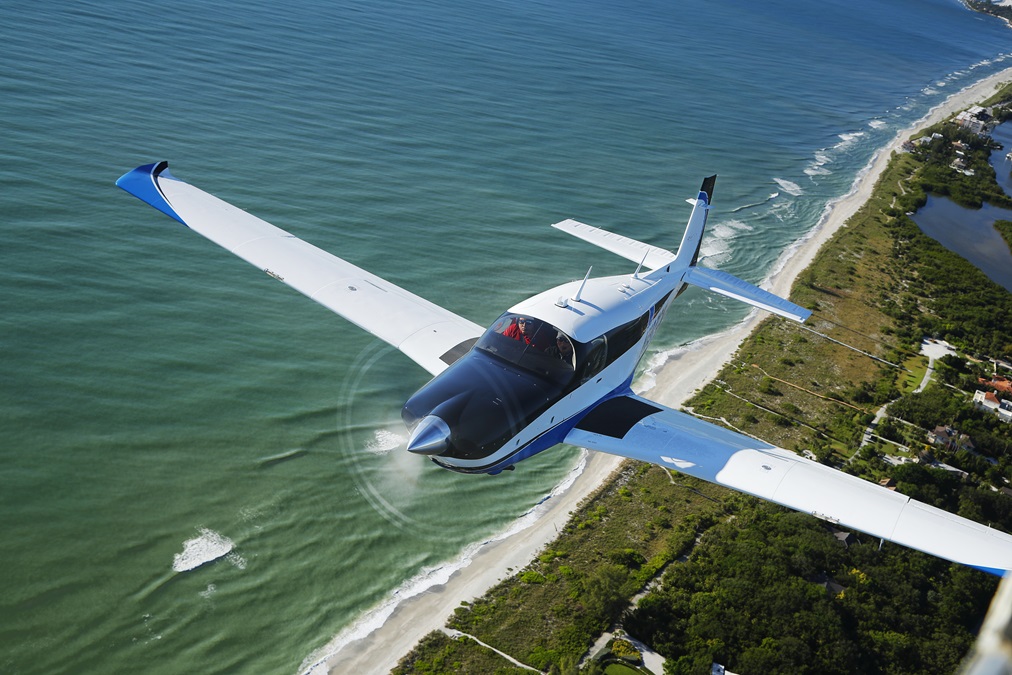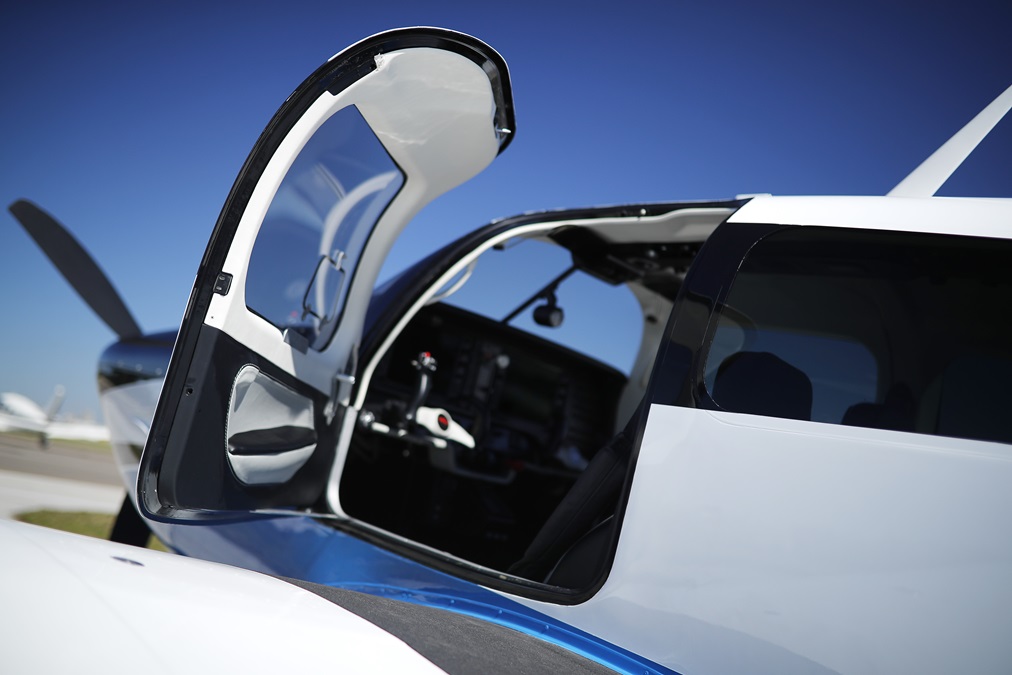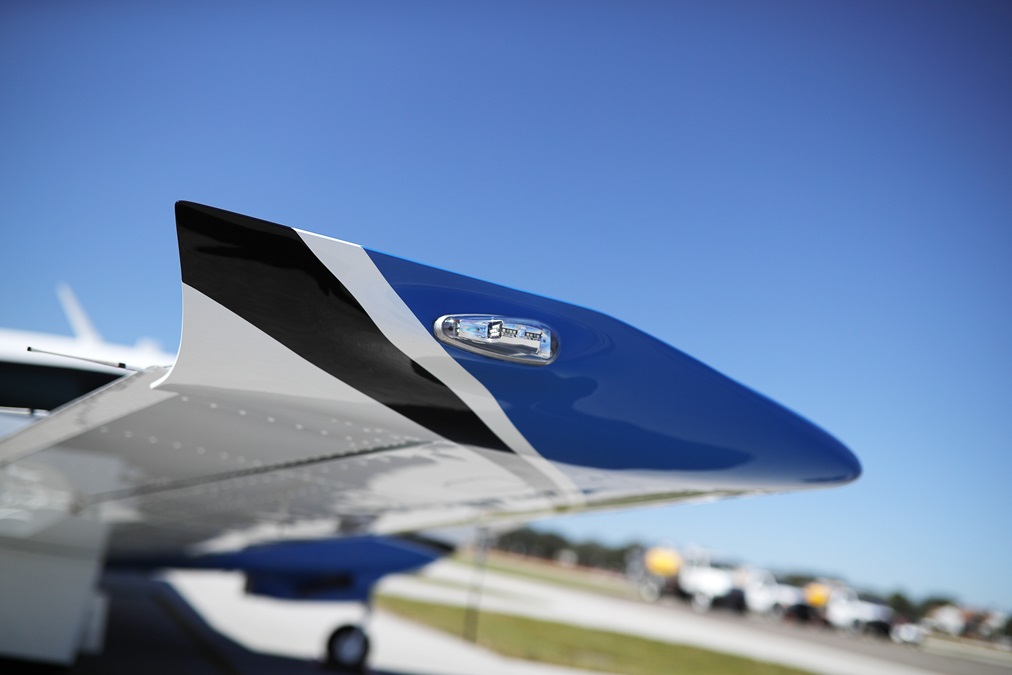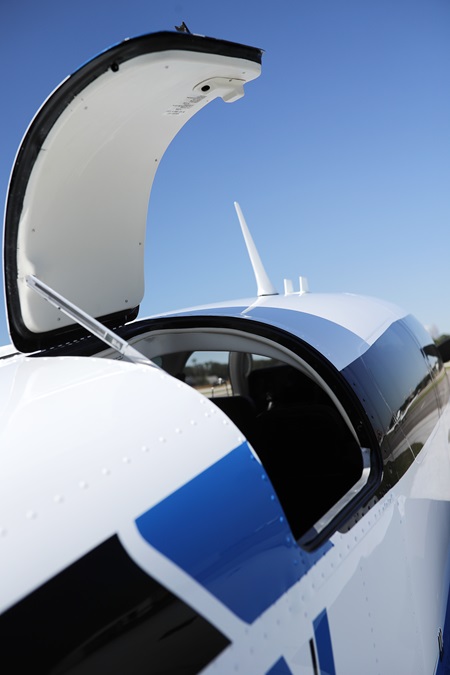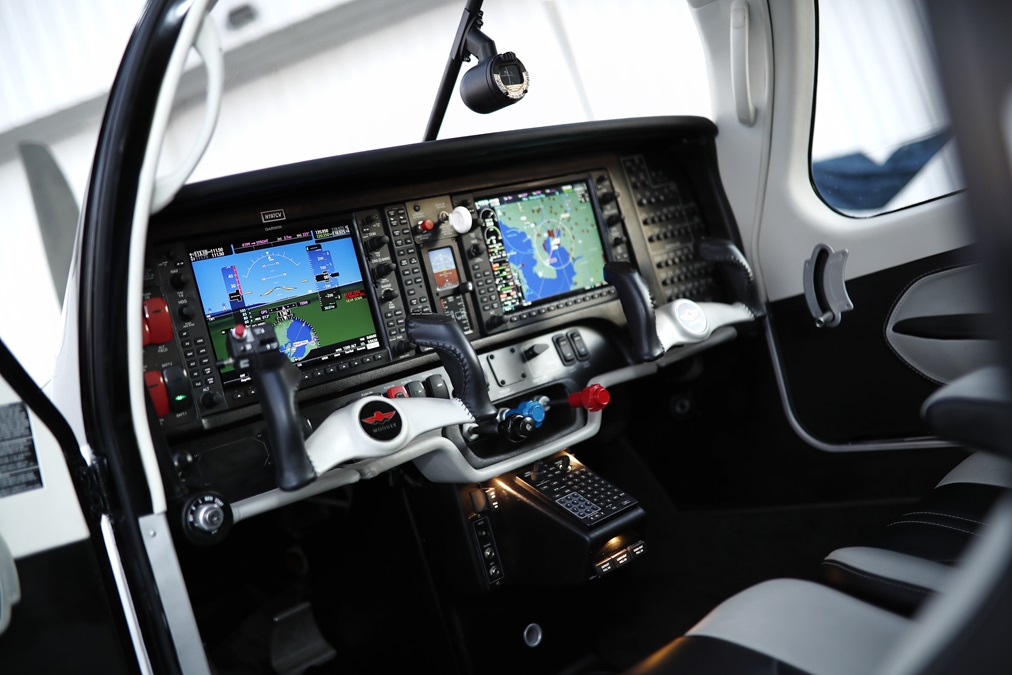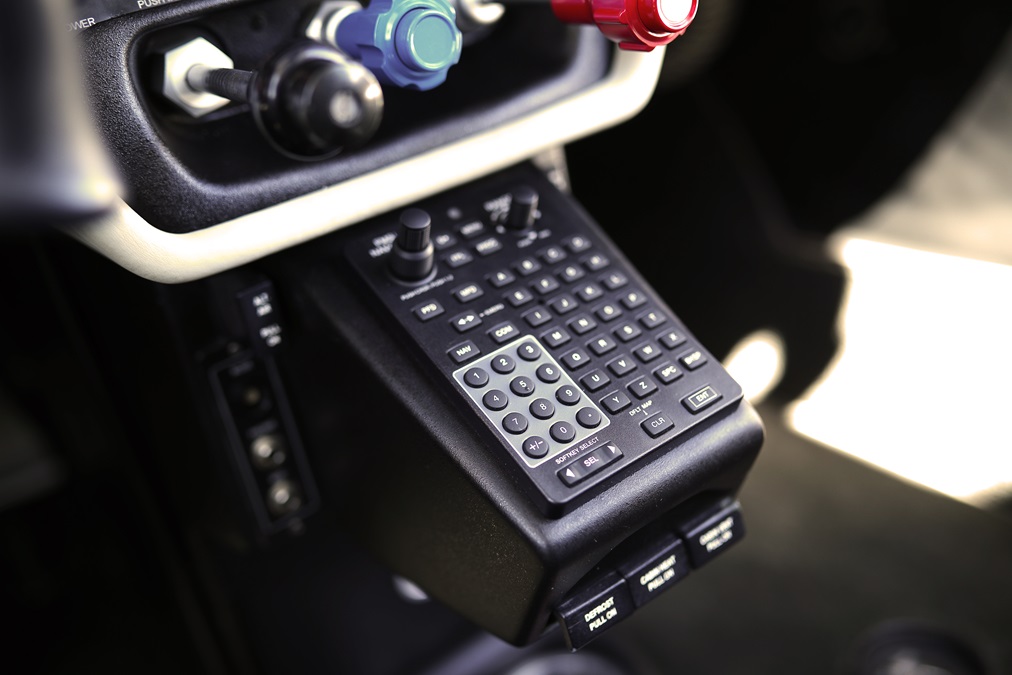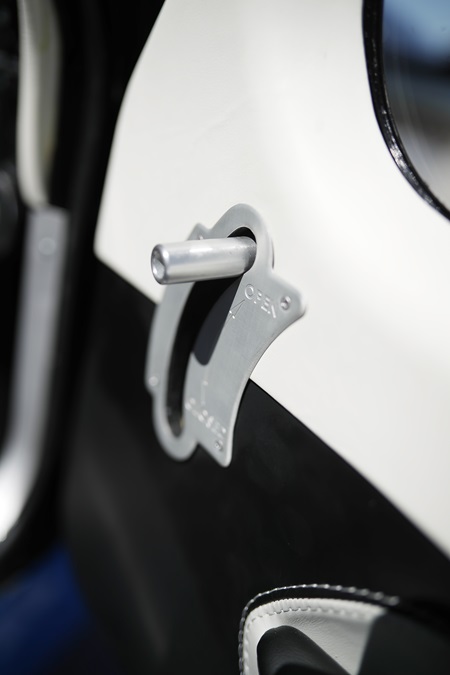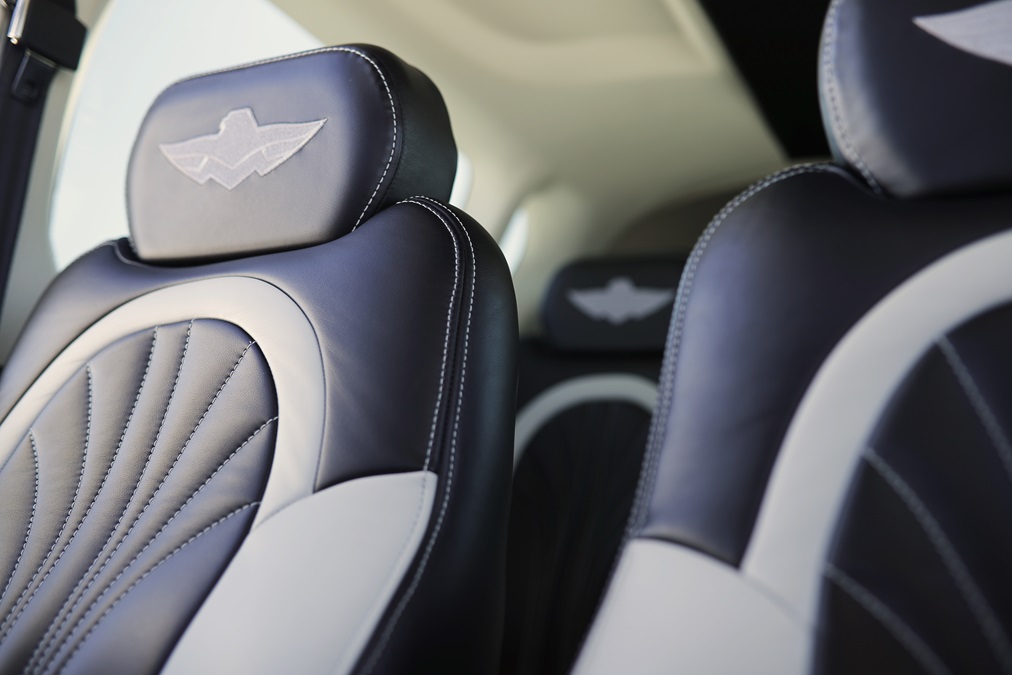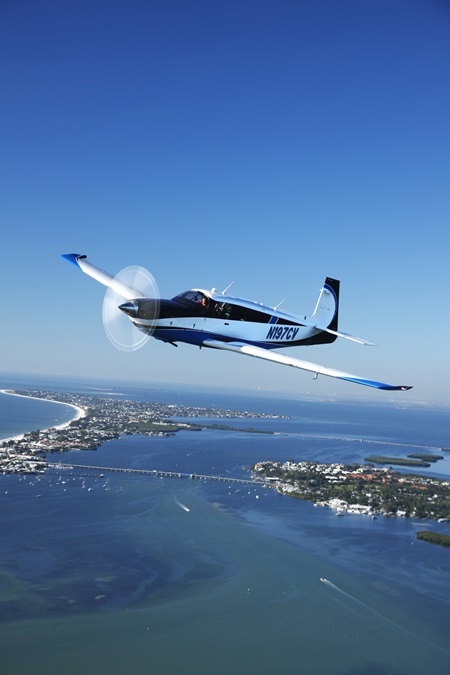Climbing back
Still lightning fast—with creature comforts
After a four-year hibernation forced by financial troubles ended in 2014, Mooney has resumed new aircraft manufacturing at its Kerrville, Texas, plant. It’s producing turbonormalized M20V Acclaim and normally aspirated M20U Ovation Ultra models that include notable changes: a pilot’s-side door, composite cockpit shell, and a Garmin G1000 NXi panel that includes keypad data entry and wireless FlightStream connections for handheld electronic devices.
But Mooney’s fanatical fans care more about speed, efficiency, and handling qualities than creature comforts—and that’s what I’m most interested in seeing from this airplane, Ovation Ultra serial number one.
We level off 6,500 feet over the Gulf of Mexico, leave the power wide open, and let the 310-horsepower Continental IO-550 work its magic as the digits in the airspeed box roll higher. I push forward on the electric trim switch with my left thumb, trying to give the airplane enough nose-down trim to counter the fast-increasing speed. The three-blade Hartzell propeller is turning 2,500 rpm, and after about two minutes of level flight, the Ovation settles at 189 KTAS (168 knots indicated) at a rich-of-peak mixture setting while burning 19 gallons of avgas an hour.
“It’ll cruise like this all day long at this best-power setting,” said Lee Drumheller, the youthful, affable, and knowledgeable Southeast sales manager for Mooney dealer Premier Aircraft. “But watch what happens when we go lean of peak. That’s where this airplane’s efficiency really shines.”
Using the big-screen NXi graphical engine monitor on the multifunction display, Drumheller dials back the red, vernier-style mixture knob until the exhaust gas temperature on each of the six cylinders peaks, then recedes. At 50 degrees LOP, airspeed drops six knots to 183 KTAS while fuel consumption falls to 14.7 gph. That’s a 22-percent drop in fuel consumption for a 4-percent speed penalty—an aerodynamic bargain.
Maneuvers such as steep turns, climbs, and descents—as well as an hour-long formation photo flight with multiple configuration changes—show off the tight, responsive, crisp control feel that Mooney pilots have always found so pleasing. Pushrod connections to the flight controls make the airplane a precision instrument. It’s a scalpel, not a butter knife.
Older, short-body Mooneys are known for heavier ailerons than elevators, but the Ovation’s control harmony is more closely balanced. “None of our competitors can match the speed and performance of a new Mooney,” Drumheller said. “Pilots who put a premium on real-world performance and handling qualities tend to be our best customers.”
A great opportunity
The Meijing Group of China has spent millions pumping new life into Mooney, and nearly 200 employees work at the Kerrville plant. Many are Mooney veterans who have lived through multiple boom and bust cycles since the company moved there in 1953—and they’ve seen dramatic changes in the general aviation market. So has Lance Phillips, Mooney’s top U.S. executive and an experienced general aviation leader.
Philips is guarded when he discusses Mooney initiatives such as the M10: a two-seat, composite training aircraft that the company announced to great fanfare and was developing in California for the international market. Mooney was testing a flying prototype, but the project has been shelved, and the company has consolidated in Kerrville while saying the M10 is still a “desire.”
Mooney is focusing on Acclaim and Ovation production, but those products face intense competition from a new generation of fixed-gear aircraft such as the parachute-equipped Cirrus SR22, which consistently outsells all other new piston singles. There are also used Mooneys on the market with similar performance to new M20s at lower prices. And a pilot who cares deeply about speed and can afford a new high-performance airplane also has options in used single-engine turboprops, such as the Piper Meridian or TBM 700, that fly higher and faster, although they also bring vastly higher operating costs.
Mooney’s turbonormalized Acclaim still holds top-speed bragging rights over the fixed-gear SR22 and Cessna TTx, as well as its traditional rival, the Bonanza G36. Mooney is betting its speed and range advantages—combined with a left-side door and new avionics—will attract enough hardcore pilots to allow the company to claw its way back into a highly competitive marketplace.
With a 197-knot maximum cruise speed and a range of 900 nautical miles at 8,000 feet, the Ovation Ultra has to break into a crowded part of the market that’s occupied by overachievers. Its turbonormalized sibling, the Acclaim Ultra, is faster; Cirrus SR22s have parachutes and a broad maintenance and support network; Bonanza G36s have bigger cabins (and two more seats), and used turboprops that can outrun all of them in terms of pure speed. Also, given Mooney’s stated aspirations in emerging aviation markets such as Asia, the M20’s appeal to high-time pilots who value exquisite handling qualities seems odd. A boxy, forgiving, SUV with wings would seem like the appropriate tool for that market.
Mooney CEO Phillips said Mooney was delivering about 90 airplanes a year in 2006 before it began its dramatic pullback. He thinks the company can find about 50 new owners next year willing to pay a premium for Mooney performance, and the company can grow from that foundation.
“Our buyers are typically experienced pilots who value superior performance and handling qualities,” he said. “We have the ability to scale our production up or down to match demand.” (Mooney workers in Kerrville also build parts for other aerospace firms and supply parts for the existing Mooney fleet to supplement income from new aircraft sales.)
Phillips said Mooney has no plans to add an airframe parachute—the key feature that differentiates the top-selling Cirrus SR series. “We’ve got a great safety record already,” he said.
Phillips said Mooney is focused on building and refining M20s while competitors are juggling multiple projects. Cirrus is devoting a great deal of its resources to production of its newly certified SF50 Vision Jet, and Textron has a broad range of sometimes overlapping products three years after the company merged the Cessna, Beechcraft, and Hawker workforces.
“We’re laser-focused on the high-performance-single market,” Phillips said. “We’ve got a great opportunity there.”
Visual approach guidance
On the ramp, the Ovation Ultra has the sleek appeal of a thoroughbred. Walking around the airplane, you notice the things that give it a reputation for ruggedness. A one-piece wing spar stretches from tip to tip, and the metal wing is held together with flush rivets on the front half and hefty round ones at the rear. Three attach points connect each aileron to the wing, and there are four on the elevator.
The trailing edge of the wing is close to the ground, but there are nonretracting metal steps on both sides for climbing on to the wing. Upturned wing tips are designed to enhance stability, particularly at high altitudes. There are LED lights on the tips and incandescent landing and taxi lights embedded in the leading edge. The Ovation doesn’t have cowl flaps, giving pilots one less thing to manage.
This airplane has multiple GPS and radio antennas protruding from the top of the fuselage, and some of them—such as the double-edged active traffic antenna—are likely to disappear as Automatic Dependent Surveillance-Broadcast becomes ubiquitous.
Opening the doors for the first time reveals them to be about four inches longer than the ones they replaced, and they open outward almost 90 degrees to provide easy access to the cockpit and rear seats.
Boarding through a left-side door will seem odd at first to veteran Mooney pilots, and there’s a trick to it. Drumheller coached me through my first ingress by having me step in with my left foot first, which felt awkward but worked well. Closing the door felt funny, too, with my right hand pulling it closed, then locking it with my left.
The seats, made in Kerrville, are stitched leather and comfortable. They adjust vertically, fore and aft, recline, and there’s an armrest between the front seats.
Engine start is normal, and the NXi avionics boot up faster than a legacy G1000 system. There’s a single keypad for data entry (not touchscreens), and there are USB ports for electronic devices in the front and back.
Taxiing is standard, and the airplane sits at a 5-degree nose-up attitude on the ground, so the cowl blocks a sliver of the view straight ahead. There are no deice or anti-ice systems on this aircraft, although TKS is an option, as is air conditioning.
We taxi to Runway 4 at Tampa’s Peter O. Knight Airport and launch with partial flaps into a 10-knot quartering headwind. Acceleration is brisk and a steady tug on the yoke at rotation speed lifts the nose skyward.
At cruise, Drumheller cranks up the XM music, picks out songs, and adjusts the volume from his iPad using the wireless FlightStream connection. That sort of thing used to require delving deep into the G1000 AUX menus, and he says handling it via the iPad takes less time and button pushing.
The NXi avionics system has rich, colorful displays, and my favorite feature is its visual approach guidance—which shows a highway-in-the-sky path to all runways in its vast database, even those without instrument approaches. It’s a handy tool, particularly in long-body Mooneys that require precise airspeed control on final. The visual approach guidance simplifies the descent and configuration changes, especially at unfamiliar airports.
The Ovation has highly effective speed brakes, and Drumheller recommends using them during descent to prevent rapid engine cooling. A final approach speed of 75 KIAS allowed us to exit the runway in about 1,800 feet at the midfield turnoff.
Challenging and rewarding
The Ovation Ultra is a sleek, stylish, sturdy, confidence-inspiring airplane that both challenges and rewards pilots with exacting standards. They appreciate its precision, speed, and flight efficiency. Roll-on landings must be earned, because this airplane doesn’t give them away. But that challenge is part of the airplane’s appeal.
The Ovation Ultra takes the best of the Mooney tradition and adds some thoughtful improvements. It’s likely to remain a highly niche product for pilot purists willing to pay a premium for speed, good looks, and crisp handling.
And that sounds like it’s just fine with the folks at Mooney.
Email [email protected]

